A hen eats about 4 ounces of food a day, and lays an egg that weighs 2 ounces. What goes in is what comes out. The quality and the ingredients of the feed matter. Raising your own chickens for eggs means that you know what your hens are eating. Chickens are omnivores and thrive on a varied diet, but they also have exacting nutritional requirements in order to be able to convert what they consume into eggs. I’ve written about what to feed chickens here.
Some people believe that blending their own mixture from individual ingredients guarantees that their hens will be consuming the very best provender possible. After all, they think, it’s not as processed as the commercial pellets. But, for many reasons, homemade chicken feed is problematic. First of all, it’s difficult to keep homemade feed fresh for a small flock because much of what goes into a ration for layers contains oils, and so turns rancid if it is stored for too long or improperly. Also, hens are picky eaters. If fed a mixture of loose grains, the hens will ignore the bits they don’t like – often eating only the carbohydrates and leaving the protein. Or, they’ll gorge on seeds and get too much protein. The homemade ration will separate – the lighter and smallest pieces will fall to the bottom. What your hens eat won’t be balanced. This also happens with commercial blends that are not pelleted, but that are composed of whole and cracked grains – I’ve heard of many ailments that arose from nutritional imbalances that occurred when grain mixes, not pellets, were fed,
My flock is fed commercial laying hen pellets. This ration is nutritionally appropriate, and it’s in a form that isn’t wasteful. It’s easy to purchase and easy to store. I understand that many people, having decided to opt out of the industrial agricultural model, would also like to opt out of buying chicken feed made by Nutrena (Cargill) and Purina (Nestle). I see this as a personal and political choice. Sometimes you don’t have an option – rations made by the big corporations might be all that is available. It might be what you can afford. Your hens will do fine on it. But, those big players aren’t the only ones making chicken feed. There are regional feed mills, like Poulin Grain. I recently asked Poulin if I could come up and tour their plant. I wanted to know exactly what goes into their feed and how it is manufactured.
I arrived on a snowy spring morning. It was a long, but beautiful drive to get there. The mill is in Vermont, on the Canadian border.
I met Josh Poulin, the fourth-generation of his family to run the mill (his sister is also involved.) Scott Birch, the Quality Assurance Manager, gave me a tour. It’s a busy place. They make a variety of animal feeds, including dairy rations, rabbit pellets and horse feed. Poulin manufactures 35 tons of laying hen pellets daily. (Which is a small amount when compared to the major feed corporations.) The plant runs around the clock – 24 hours a day.
Feed arrives by rail and truck.
It comes in from the Canada and the midwest. Much of it comes in a milled form. There is storage in classic silos.
Milled grains are accessed from these bins. There is a fine dust from the light, soft grains, which covers every surface, but the facility is tidy and smells clean. The Poulin feed does contain soybean meal. It is a readily available, digestible, and affordable vegetarian protein.
There are conveyor belts everywhere to move grain from one place to another.
Some ingredients arrive in bags.
Poulin laying hen pellets include three essential oils, obtained from oregano, cinnamon and chili peppers. These help to keep poultry healthy without the use of added antibiotics (as is often seen in industrial agriculture.) They also add a product called Bio-mos which takes on a role similar to probiotics – it reduces bad gut bacteria and increases the good, which in turn promotes feed efficiency and health.
Because grain varies in its nutrient content, what comes in is analyzed in their lab. A computer takes that information and determines exactly how much of which grain goes into the product. The finished feeds are also periodically tested to ensure that the ingredient analysis on the label is accurate.
Each ingredient is measured on digital scales. It’s then sent on through the feed-making machinery. This is all controlled at a central computer. When I visited, Jason was orchestrating this complex job. Jason grew up on a local dairy farm. His family still milks cows. He cares about what goes into the feed.
The ingredients get mixed in hoppers.
Some of the machinery relies on gravity. I climbed many stairs.
Once the ingredients are mixed, the feed is pushed at high pressure through the pelleting wheel. This is what it looks like.
It is in this machine.
The grains are not cooked, but heat is generated as the pellets are forced through the molds. Nutritional value isn’t affected, however starches do gelatinize. There’s a tad of water, vegetable oil and binder added to the mix, but mostly the pellets hold together because they are compressed as they are extruded through the holes.
The pellets then get bagged. (This machine is getting replaced soon.) By the way, the only difference between crumbles and pellets is that the crumbles are broken into small pieces before bagging.
The bags are then put onto pallets and moved into the storeroom. There isn’t room to keep it around for long. It’s gone within days, but Poulin guarantees the quality for three months.
The whole place was a bit like a Rube Goldberg machine. So many complicated parts to make what seems like a simple product.
It might look boring to you, but my hens find it quite appetizing!
Note: The ads that you see on my website are put up there by Google Ads. I get a small amount of income from them. I have no control over their content. However, there is a Poulin Grain advertisement on my What to Feed Your Chickens FAQ. Because I feed Poulin laying hen pellets to my flock, I asked them if they’d like to place a banner advertisement on that page. I appreciate both their product and their financial support of what I do here at HenCam. I asked Poulin if I could visit their mill. I did not get paid for this blogpost.








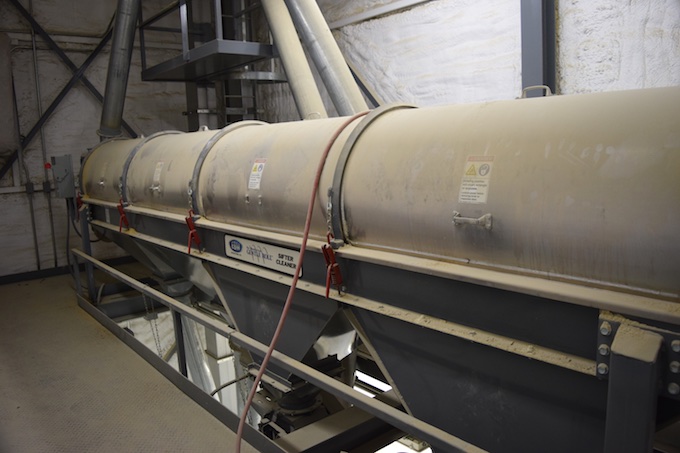

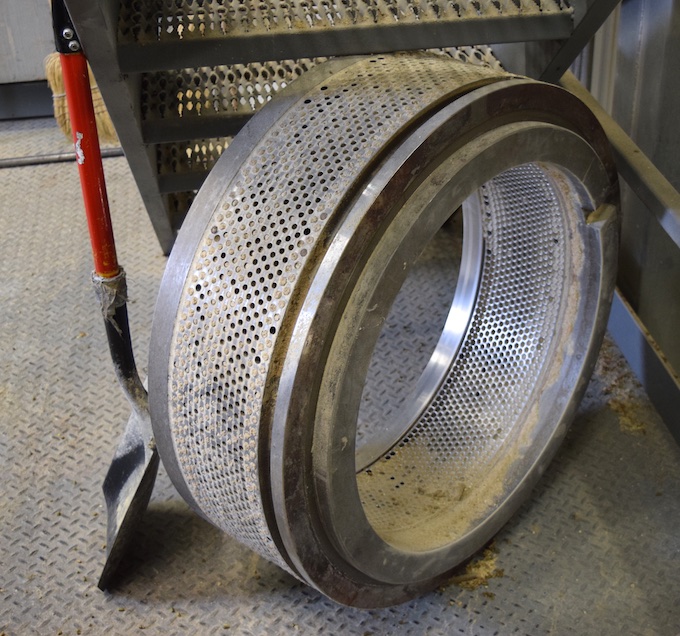
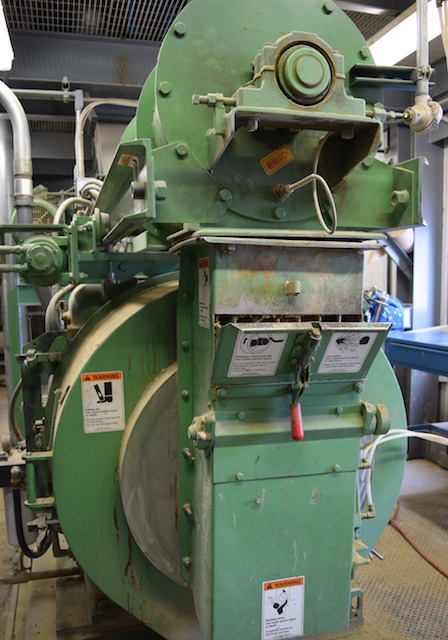
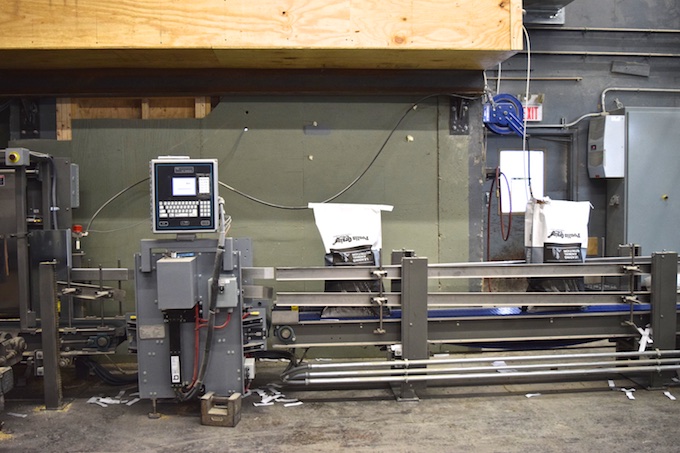
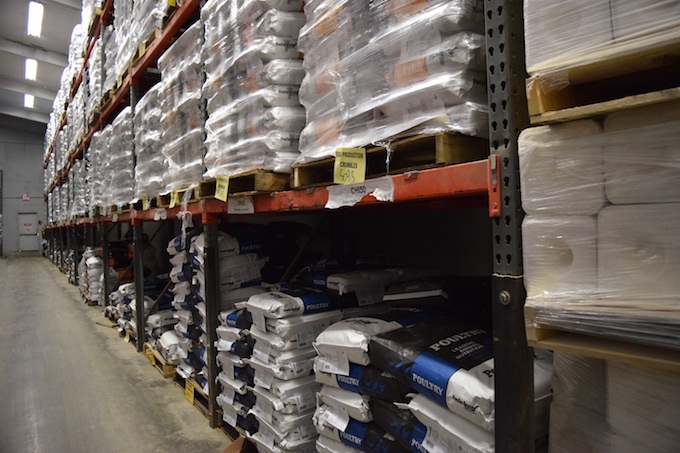
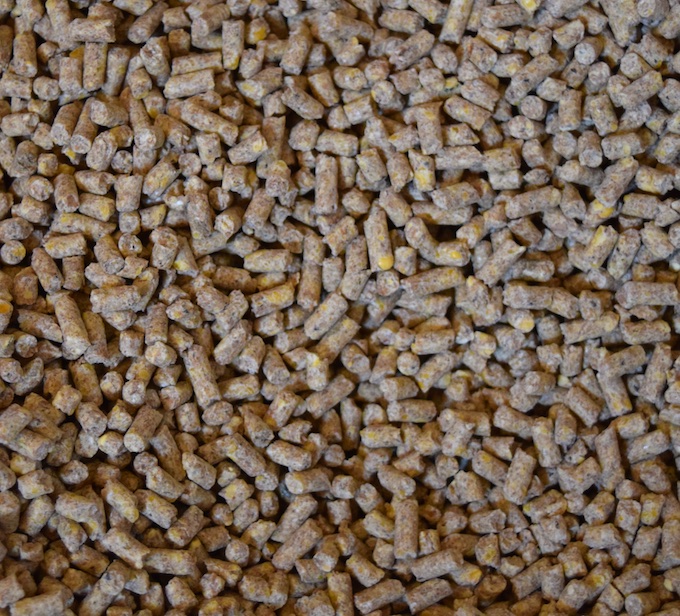
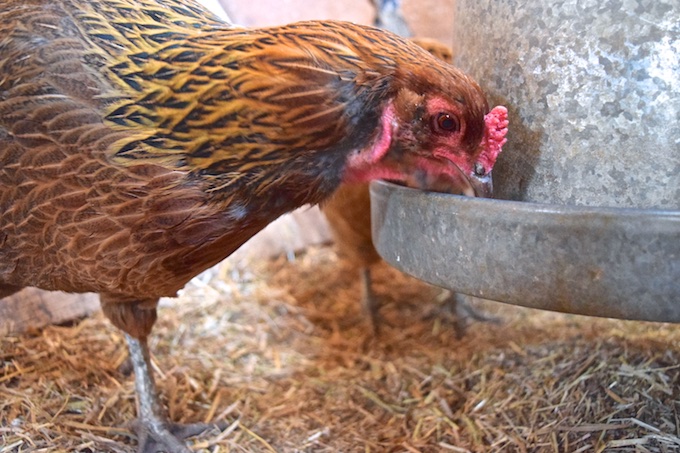

I wish I had access to pelleted feed but there is no one even in my region that sells it. Apparently, the pelleting machines are very pricey and there is a small mill nearby that is looking into expanding and purchasing one but for now, the mash is certainly quite wasteful…when the dusty bits add up at the bottom of the feeder about once a week, I mix it with the dregs left over from when I make soy milk and serve it to them as a wet mash…they like it and I ensure that they are getting everything they need. These last two warm days though, I have moved the girls to the veggie garden so that they could till for me. They did such a good job (partly because I threw a bit of straw around on top) that I got the peas, lettuce and spinach planted last night before a light rain!
You are ahead of me in planting! I didn’t realize that in some places only mash is available. That’s a small part of the market for feed, and is usually made for those few old-time holdouts.
I have been feeding Poulin feed for some time now. Very happy with it. I have to drive about 15 miles each way to get it, the stores near me do not have it yet. I like the fact that it is New England based and not one of the “big boy” companies. This was a very interesting and informative post.
Love the smell of a feed mill.
When you actually look at what goes into making feed from growing, harvesting, transporting, testing, processing, bagging, shipping and retailing it is really amazing it only costs what it costs.
Agreed.
Thank you so much for this wonderful information. I have been using Poulin Grain for my hens and horses for a long time, but never knew much about where it was made. Thankfully, it is not difficult to find around here and have delivered.
Wish I had access to Poulin but it’s not available locally here in Texas. Struggling to find a good feed for my girls that isn’t Purina or Nutrena. Any suggestion?
I’ve no idea about local feed mills in Texas. Anyone want to help Barbara out?
I did find Texas Natural Feeds that I can get locally and it’s reasonably priced. It’s Non GMO and it made with peanuts & Sorghum. Other feeds I’ve found tho Non GMO contain corn & soy and are very costly. Anyone familiar with this brand?
Holy smokes Terry…this is such an informative post!! So much work went into this! Thanks for putting it all together in layman`s terms that we can all process. :)
It was a lot of work :) but what I love about what I do is that it gives me the excuse to delve into things that I want to learn more about.
Very, very interesting article. I have tried different pellets in UK the one I use and prefer is Marriages it is made with Non GM Ingredients and No Artificial Pigments. There is a mix of 8 Seed and Grains, Soya Bean Meal, Lucerne, Balanced Vitamins and minerals, and special Oils. The Girls really enjoy it and will come running for a handful the same as any other treat ( they have it ad-lib in their feeder all day ). It is more expensive but worth the money, and they do a smaller bag with Flubervet wormer already mixed in should you need it which is very handy :)
I was born & raised in Newport and went to school with a Poulin. However, this has nothing to do with hen pellets. :)
Yes it does – I don’t think that anyone can say that they went to school with a “Blue Seal” :)
Right……:)
Fascinating!
Wonderful article! Enjoyed it thoroughly. I love seeing how things are made!
Thank you for investigating and posting how pellet are made! Would love to buy some Poulin mash but I am in California – I will call them and check if they will ship over a bag, maybe they can start mail order (boy I sound “old”!) delivery!
The Girls are scratching around outside and Phoebe’s has finally got some peace hunkered down in her den, lovely to see. :)
Thanks Terry,
I love knowing how things are made and love seeing pictures of the machines! ( I am a machinest) and I use poulin layer pellets too!
Some good information. I’ve never heard a chicken described as being “Picky eaters” on their diet. Perhaps I was making that assumption based on their behavior: If I had something in my hand, they wanted it. One of them actually jumped up and stole an apple slice from me while I was talking to a friend. Teach me to just let my arms dangle at my sides….. Been letting them free range a lot, but I always make sure their feeder is up to par. At any rate, thanks for the legwork, and for giving my thinking a boost. I haven’t given their feed much thought, but I might look around a bit to see what is available, and what’s in it.
Hens are voracious eaters, but, given a choice, they are quite selective. The protein in non-soy rations is often from plants like field peas, that the hens don’t like as much as the other grains. They’ll toss it aside while they gorge on the other stuff.
What a great post Terry…I really enjoyed it…what an interesting field trip!
Thanks for this! I do not have chickens but live through all of you that do!
Two of my 3 girls were having issues with laying shell-less eggs at the end of their 1st year which evolved (devolved) into a mostly egg free 2nd year. I wanted to make sure that it wasn’t nutrition-based so I cut back on treats like oatmeal. It didn’t seem like they were eating their organic pellets so I switched to organic crumble. They made a mess of that by pecking out the good bits and flinging the rest to the ground. Then I switched back to the pellets and added extra brewer’s yeast with garlic, a probiotic, and kelp. They seemed to eat more but it wasn’t until I read your post and started adding alfalfa that they ate with gusto. I bought a bag of alfalfa pellets at the local feed store because the clerk said that he fed them to his chickens. Ha! The pellets are too large, probably for rabbits, so I have to crush them in my blender. The outcome? One girl is back to laying 6-7 eggs a week. The other is still laying softies. But they are both much healthier this year so I hope it was something in the food. Who knows with chickens?!? Thanks for the informative post. I would never had imagined that they didn’t add liquid when making the pellets.
Loved the post!
Thanks again Terry for such an informative post. I have been switching hen food lately trying to find the one we like the most and your post came at such a perfect time. I DO notice that with some products, the girlz pick out what they love and fling the rest to the ground. Such a waste and probably not getting what they need from the feed. So…back to pellets we go. i will do some better research on my pellet purchase, but at least I feel better thinking they are getting more whole nutrition by eating a pellet than picking out the yummiest parts of a crumble mix. Better for them AND for my wallet!
Glad that I helped!